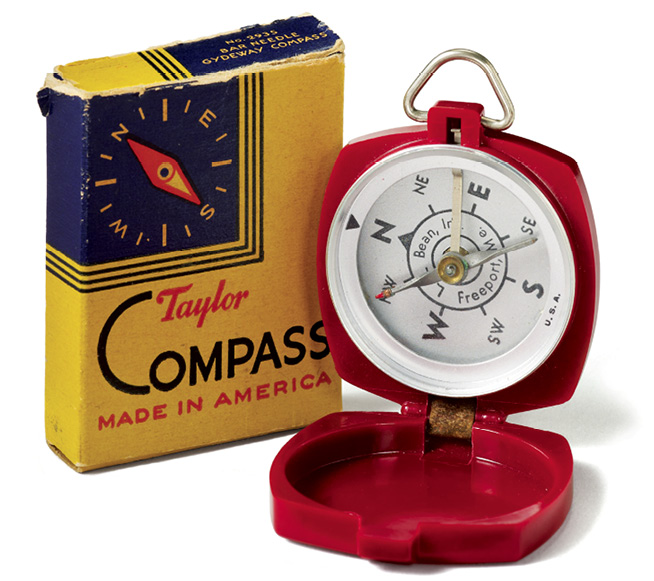Chapter 15
How to Use a Compass
There is no excuse for getting lost if you carry a good compass and know how to use it.
Camping places are invariably located on trail, tote road, stream, lake, telephone wire, etc. We will say that your camp is on a good sized stream or well defined road running North and South. You cross the stream or road and hunt to the East for several hours. When you want to go to camp all you need to do is travel West. Hold compass so needle arrow points to “N” then pick out some object in a due West direction and go to it. Keep repeating this and you are sure to hit your road but it may be a mile or more below or above your camp. You are out of the woods anyway and if you have been over the road a few times you will soon see landmarks that will tell you which way to go.

L.L. Bean felt the dials of most compasses were too “cluttered up with figures, lines, and ornaments.” So he created this plain dial for ease of use “even on a very dark day.”
Lakes, old railroads, telephone wires, etc., always run in some general direction and you must be sure of this direction when you start out and always be sure which side you are hunting on.
Before starting out I usually get someone in the party to help make a rough sketch of the territory and always carry it with me. A rough map of this kind is a big help to find the very shortest way to camp.
At times you will feel sure your compass is wrong. The best way to overcome this feeling is to carry two compasses. In checking one compass against the other, place them eight to ten feet apart and away from your gun or other metal. Another reason for carrying two compasses is that one might get broken. In fact, compasses have been known to get out of order. When compass needle swings back and forth several times and finally settles in the same direction on two or three tests, it is O.K.
The modern tool for navigating the outdoors is the Global Positioning System (GPS) receiver. Besides providing your exact position on the earth, a handheld GPS will guide you to your destination, give you information to keep you on course and tell you how far you have to go. It lays electronic breadcrumbs called “waypoints” so you can retrace your route, even on the sort of spontaneous side trip that might cause a lesser-equipped hunter to lose his way.
At first, only the military used GPS, but quality mapping devices can now be had for about the cost of a riflescope or good tent. Of course, technology will continue to improve at a fast clip, and both features and prices are sure to change.
While sophisticated, the technology is not difficult to master. The GPS searches the sky for satellite signals. When the GPS finds at least two signals, it establishes your current latitude and longitude and displays your location on a digital map on the screen.
Today’s units are so powerful it is no longer necessary to stand in a clearing to get a signal; a clear view of the sky is sufficient. To get the best results, remember to stop and lock into a signal before you head into the trees. If you are wearing a backpack, fix the GPS to the shoulder strap so it is pointed at the sky. If you carry the unit in your hand, avoid swinging your arms because the movement can confuse the receiver.
If you own a GPS, you may be tempted to throw away your paper map and compass. Don’t give in to that temptation. Batteries can die. Heavy tree cover and steep and narrow valleys can interfere with satellite signals. And if you drop your GPS in a stream, it may cease to function altogether. The best piece of gear that you take into the woods is the one between your ears. No piece of technology replaces a working knowledge of traditional navigational skills.
— Bill Gorman